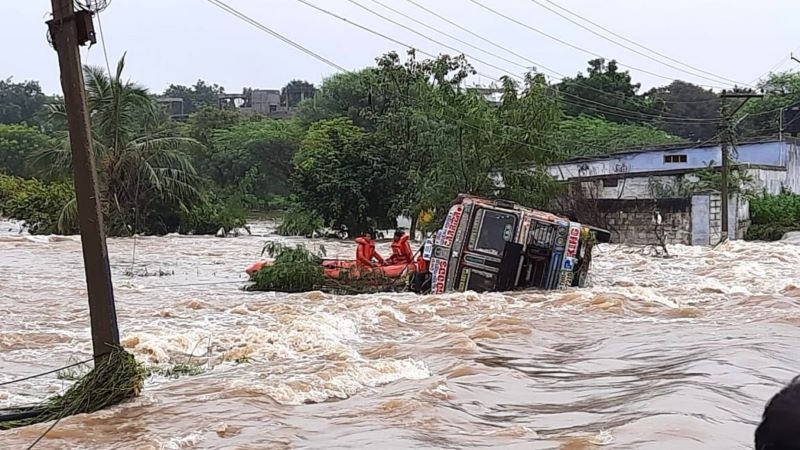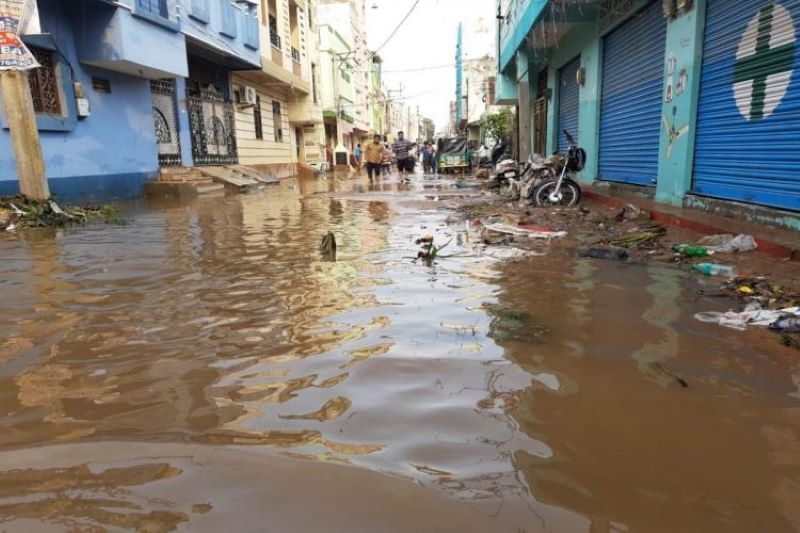Annual Floods – Natural Disasters or MANMADE?

Annual recurring “Floods” are not “Natural Disasters”; but “MANMADE”. Political leaders and their supporting bureaucracy are squarely responsible for recurring annual disasters.
Annual “Cyclones” are also not “Natural Disasters” but a “Natural Phenomenon” without whose annual visitation at least 8-10 times (NE and SW Monsoons); India suffers from “Drought and Famines”.
Study “Data on Floods and Cyclones” mercilessly expose the realities of root causes of abject government failure, particularly at the State and Municipal levels.
Recently in the media featured the local Minister directing the Cantonment Board elected members to assert their authority to authorize illegal encroachment and construction activities in the official meetings. What can one expect from such arrogant and ego-centric political leadership except for promoting disasters?
Ironic but true, even the government has constructed two-bedroom houses for BPL families which are today standing in floodwaters.
In the past, a media column succinctly summed up the realities: “India's political spectrum has undergone a rapid transition over the last 65 years. Governments changed, leaders rose and fell, parties were formed and exterminated, issues and priorities too saw a sea of change, but what remains an eyesore is that despite their annual nature, floods continue to maim states, claim hundreds of lives and ravage valuable resources. Whether it is Assam and Arunachal Pradesh in the Northeast, Bihar, West Bengal and Uttar Pradesh in the Gangetic plains, Uttarakhand, Himachal Pradesh and J&K in the hills, Madhya Pradesh and Chhattisgarh in Central India or the southern states of Kerala, Tamil Nadu, Karnataka, and Andhra Pradesh, the story is the same.”
For example, every year since 2015, “Floods” and the havoc caused in Hyderabad have made headlines to include: September 29/30, 2016, 16.7 cm rain breaks 16-year-old record; and flood many colonies; Oct 8, 2017 - Heavy rains flood many colonies and Telengana third most vulnerable to flooding; Aug 21, 2018 — flooding of many low lying colonies; 2019 - record rain and heavy flooding brought life to a crippling halt, killing at least 15 people and causing waterlogging in various parts of the city: and now the latest flooding in 2020.
In the 1950s and even up to the 1970s, Hyderabad was known as the “City of Lakes” – nearly 3000 lakes. More than 50 percent of them have disappeared. In one decade, Hyderabad lost about 3245 ha of water bodies. It is estimated that there were 932 tanks in 1973 in and around Hyderabad which came down to 834 in 1996. Consequently, the area under water bodies got reduced from 118 to 110 sq.km. About 18 water bodies of over 10-hectare size and 80 tanks of below 10-hectare size were lost during that period. A yet another study on land use/land cover for Hyderabad and a large area around reveals that the area under water bodies has come down from 2.51 percent of the geographical area in 1964 to 2.40 percent in 1974 and to 1.57 percent in 1990. The decline during the 1974-90 periods has been sharp; now it is sharper with rapid growth due to massive development since 1990 with water bodies has been declining over time due to urban sprawl.
In their place, “Mega Building Structures” has been sanctioned by the GHMC to come up. For example, today, adjoining the highway to Patancheruvu near Chandanagar, the two lakes – Gangaram Cheruvu and Bhachuu Kunta Cheruvu - stand testimony to the havoc of the creation of “Cement Jungles”. Even the Alwal Lake bed encroachments are living examples with the outflow canals to Tirumulgherry inhabited by authorized colonies since the 1970s up to Bon Cheruvu in Tirumulgherry area and beyond.
There were 169 large water bodies to include: Husain Sagar, Osman Sagar, Himayat Sagar, Shamirpet Lake, Mir Alam Tank, Safilguda Lake, Ramakrishnapuram Lake, Kapra Lake, and so on. HUDA, in the first phase, proposed to restore 87 lakes. But what are the realities? The 2019 Hyderabad Bachao Twitter report “Rocks Bachao, Lakes Bachao, Heritage Bachao, and Errum Manzil Bachao. This is a shout out to all those who have been fretting about how Hyderabad has been changing rapidly.” Surely, the State Government is culpable of turning a “Blind Eye” to civil society warnings repeatedly. And, then blame nature for the woes on annual basis.
In Hyderabad, the root causes for colonies submerged by floods on annual basis are simple. It is the collusion of the local political leadership directing GHMC officials to sanction buildings in low lying areas violating “Master Plans” resulting in the near-total concretization of the city, unauthorized encroachment into lake beds, sanctioning buildings in low lying areas and their outflow canals, abject failure in provisioning adequate rainwater drainage pipelines (sizes), non-implementation of scientific water harvesting structures; etc.
Similarly, the data on floods in almost all the states following year after year. They include 26 July 2005 - Heavy rains across the state of Maharashtra that killed at least 1,094 people; June 2013 North Indian floods: mainly Uttarakhand and nearby states. More than 5,700 people were presumed dead; June 2015 Gujarat flood: widespread flood in Saurashtra region resulting in more than 70 deaths; 2015 South Indian flooding of Adyar, Cooum rivers in Chennai, Tamil Nadu; 2016 Assam floods affecting 1.8 million people and flooding the Kaziranga National Park killing around 200 wild animals; 2017 Gujarat flood resulting in more than 200 deaths; August 2018 Kerala Floods resulting over 445 deaths; August 2019 Indian floods: that affected over nine states in India; and the annual feature of Brahmaputra floods.
The harrowing images of multi-story concrete buildings being washed away like decks of cards in the violent waters of Mandakini and Alaknanda (tributaries of the Ganga) in Uttarakhand in 2013 of “Devbhoomi” - Kedarnath, Badrinath, Gangotri, and Yamunotri has been dumped into the dustbin of history.

What to talk about the Assam government’s failure to mitigate the flood havoc; the question that the other state governments must answer is why they have failed to do so in their own backyards.
And, it is usual for the State governments to demand from the Central Government for allocation of funds for providing relief and rehabilitation to cover up their shortcomings, failures, and collusion with local people responsible for allowing habitations to come up in low lying areas. Furthermore, the State Governments rise astronomical financial support and blame the Central Government for not meeting their demands.
It is practice for a Central Team to visit and physically verify the extent of damage and destruction to finally recommend the financial aid to be given by the Central Govt. Also, there are laid down procedures to receive all aid/assistance from International Organizations like the UN Disaster Agencies, Red Cross, and others besides aid from foreign nations. Surely, all such foreign funding cannot be allowed to fill the coffers of vested interest groups.
For example, in 2005 floods in Maharashtra, the State Government projected Rs. 6000.00 crores loss and the Central Government after physical survey allotted Rs.700.00 crores only.
Also, quite a regular feature to rake up controversy and blame the Central Government for inadequate and timely disbursement of funds by the Centre for carrying out repair activities in time.
However, the case of Assam is different from the rest of India. Flood-control methods deployed in Assam have actually worsened the problem. Embankments are the most widely used engineering interventions against floods in Assam. Flood mitigation plans and effort in the Brahmaputra are not backed by scientific research and wisdom of riverine communities, for the most part. This has resulted in an array of flawed top-down measures over the years that have done more harm than good. Add to it, near-total deforestation of age-old pristine forests in the hills Arunachal Pradesh, Nagaland, and Meghalaya. No longer, the forest canopy and the undergrowth absorb and retain rainfall and its outflows.
The Indian state technocracy has long advocated big “multipurpose dams” as the panacea to Assam’s flooding problems. But local communities and many researchers of the Brahmaputra say experiences so far suggest they are a recipe for disaster. According to the latest earthquake zone map, the entire Northeast is in Zone 5, which is, the highest vulnerable Zone.
Furthermore, States indulge in blame games against neighbors for releasing flood overflows from dams located in their regions like Kerala laying blame on Tamil Nadu for their owes.
In sum, the controversy over Central and foreign agencies' financial aid and the blame games on the neighboring states are just meant to divert the attention of people to cover up the local Municipal and State Government failures and collusion and complicity for creating “Man-Made Disasters”.
Having created the “Total Mess” in low lying areas and tank beds over the past 3-4 decades in Hyderabad and elsewhere in towns, in no way the ruling party can overnight carry out the demolition of approved-cum-authorized buildings for which even the people are equally responsible for initiating the demands for house construction.
Unless the State Governments undertake massive underground rainwater drainage and water harvesting schemes based on the scientific modeling of the highest rainfalls, in no way there is a route out from avoiding such annual recurrence.
Thus, political controversy and the cacophony on the visual media are primarily intended to cover up “poor governance” or failure to implement pro-active disaster mitigation measures at the municipal and State Governments levels.
Sooner than later the normal will be restored due to air weather and life in low-lying areas will return to normalcy. By throwing “Crumps” in the name of relief and rehabilitation, political leaders will reclaim their status to continue with their approvals of unauthorized buildings and colonies.
And, it will be as usual sooner than later – encroachments and illegal construction activities with no remedial measures implemented.


